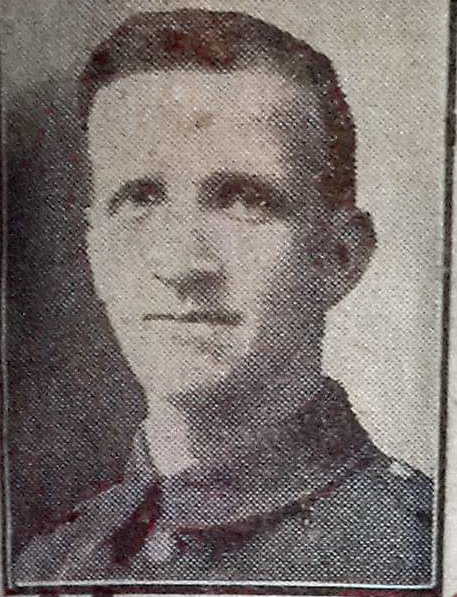L/Cpl
Irving Dent Veitch
Informationen zu Geburt
|
Geburtsdatum: 14/07/1882 |
|
Geburtsort: Penicuik, Midlothian, Vereinigtes Königreich, Schottland |
Allgemeine Informationen
|
Beruf: Schreiner |
Informationen zum Armeedienst
|
Land: Vereinigtes Königreich, Schottland |
|
Truppe: British Expeditionary Force |
|
Rang: Lance Corporal |
|
Dienstnummer: 31377 |
|
Einberufung ort: Glencorse, Midlothian, Vereinigtes Königreich, Schottland |
|
Einheiten: — Royal Scots (Lothian Regiment), 12th Bn. (Letzte bekannte Einheit) |
Informationen zu Tod
|
Sterbedatum: 12/10/1917 |
|
Sterbeort: Wallemolen, Passendale, Belgien |
|
Todesursache: Im Kampf gefallen |
|
Alter: 35 |
Gedenkstätte
|
Tyne Cot Memorial Tafel: 12 |
Auszeichnungen und Orden 2
|
British War Medal Medaille — 28/07/1920 |
|
Victory Medal Medaille — 28/07/1920 |
Punkte von Interesse 3
| #1 | Geburtsort | ||
| #2 | Einberufung ort | ||
| #3 | Ort des Todes (ungefähr) |
Meine Geschichte
Lance Corporal Irving Dent Veitch served in the 12th Battalion Royal Scots, of the 27th Brigade part of the 9th (Scottish) Division. On the 12th of October 1917 the Scottish Division participated in the First Battle of Passchendaele, a stage of the Third Battle of Ypres. It advanced at 5.35 a.m. with the 26th Brigade. The 27th Brigade was in support and followed closely. The 26th Brigade took the lead and was to capture the first two objectives, while the final objective was allotted to the 11th and 12th Royal Scots of the 27th Brigade.
At 10.25 a.m. the 12th Royal Scots – on the right of the Divisional front - moved through the units of the 26th Brigade. The attack had been chaotic and several units were intermingled by the time the Royal Scots started their advance. A mixed body of 12th Royal Scots along with platoons of the Seaforths and Black Watch pushed forward and entered the eastern outskirts of the hamlet of Wallemolen. However things soon took a turn for the worse. The German defenders had successfully halted the attack of the New Zealand Division on the right and the advance of the 18th Division on the left, exposing both flanks of the 9th Division. With the flanks up in the air the 9th Division was now enfiladed by heavy machinegun fire coming from both flanks. Any further advance became impossible and the 12th Royal Scots were forced to withdraw and consolidate a line from the cemetery on the right to Inch House on the left.
The 12th Royal Scots held the frontline till they were relieved during the night of the 13th and 14th of October 1917. The whole attack had been a disaster. Artillery support had been ample. The barrage had failed to take out concrete strongpoints and many shells fell short on the advancing troops. The Scots had run right into a trap. While concrete positions on the left and the right of the 9th (Scottish) Division held up the 18th Division and the New Zealand Division, the Scots ran into a salient, exposing their flanks to German machinegun fire. The 12th Royal Scots were cut to pieces in Wallemolen and the battered Battalion was forced to fall back.
The 12th Royal Scots suffered a total of 308 casualties. Almost half of the Battalion had been wounded, was missing or had been killed. Lance Corporal Irving Dent Veitch was killed in action during the attack on Wallemolen. He has no known grave and is remembered on Tyne Cot Memorial.
At 10.25 a.m. the 12th Royal Scots – on the right of the Divisional front - moved through the units of the 26th Brigade. The attack had been chaotic and several units were intermingled by the time the Royal Scots started their advance. A mixed body of 12th Royal Scots along with platoons of the Seaforths and Black Watch pushed forward and entered the eastern outskirts of the hamlet of Wallemolen. However things soon took a turn for the worse. The German defenders had successfully halted the attack of the New Zealand Division on the right and the advance of the 18th Division on the left, exposing both flanks of the 9th Division. With the flanks up in the air the 9th Division was now enfiladed by heavy machinegun fire coming from both flanks. Any further advance became impossible and the 12th Royal Scots were forced to withdraw and consolidate a line from the cemetery on the right to Inch House on the left.
The 12th Royal Scots held the frontline till they were relieved during the night of the 13th and 14th of October 1917. The whole attack had been a disaster. Artillery support had been ample. The barrage had failed to take out concrete strongpoints and many shells fell short on the advancing troops. The Scots had run right into a trap. While concrete positions on the left and the right of the 9th (Scottish) Division held up the 18th Division and the New Zealand Division, the Scots ran into a salient, exposing their flanks to German machinegun fire. The 12th Royal Scots were cut to pieces in Wallemolen and the battered Battalion was forced to fall back.
The 12th Royal Scots suffered a total of 308 casualties. Almost half of the Battalion had been wounded, was missing or had been killed. Lance Corporal Irving Dent Veitch was killed in action during the attack on Wallemolen. He has no known grave and is remembered on Tyne Cot Memorial.
Quellen 3
|
12 Battalion The Royal Scots , (The National Archives, KEW (TNA), WO 95/1773/2). https://discovery.nationalarchives.gov.uk/details/r/C14303 Weitere Quellen |
|
229 Infantry Brigade (formerly 2 Dismounted Brigade): Headquarters (1917 Jan - 1918... , (The National Archives, KEW (TNA), WO 95/4677). https://discovery.nationalarchives.gov.uk/details/r/C14303 Verwendete Quellen |
|
McCarthy C., Passchendaele. The Day-by-Day Account, (London, Uniform, 2018). Verwendete Quellen |
Weitere Informationen 3
|
Commonwealth War Graves Commission Database https://www.cwgc.org/find-records/find-war-dead/casualty-details/825402 |
|
Namenlijst (In Flanders Fields Museum) https://namenlijst.org/publicsearch/#/person/_id=825cc22e-78a0-477f-8af4-7a2c654c0221 |
|
Lives of the First World War (Imperial War Museum) https://livesofthefirstworldwar.iwm.org.uk/lifestory/4553911 |
